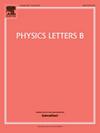从摄动Bianchi I背景下的引力波推断出哈勃参数
IF 4.5
2区 物理与天体物理
Q1 ASTRONOMY & ASTROPHYSICS
引用次数: 0
摘要
在远离二元源的Minkowski背景下,将引力波解以v/c为一阶,并将其适应于friedman - lemaitre - robertson - walker (FLRW)背景,代表一个膨胀的各向同性和均匀的宇宙,这是很简单的。我们发现了轻微各向异性背景的类似解,这可能是对引力波传播的晚期宇宙的更准确描述,并且根据修正的引力模型和哈勃张力,严格的CMB各向异性约束的含义可能不一定决定晚期宇宙的各向异性水平。我们使用比安奇I度规的微扰形式,并演示波形如何不同。利用超新星各向异性数据作为参考,我们发现在Bianchi I背景下推断的光度距离与FLRW背景下推断的光度距离平均相差2.1%。根据观测方向的不同,这种差异可高达5.9%。因此,从引力波数据中推断哈勃参数时所使用的背景时空应慎重考虑。本文章由计算机程序翻译,如有差异,请以英文原文为准。
Inferred Hubble parameter from gravitational waves in a perturbative Bianchi I background
It is straightforward to take the gravitational wave solution to first order in far from a binary source in a Minkowski background and adapt it to the Friedmann-Lemaitre-Robertson-Walker (FLRW) background, representing an expanding isotropic and homogeneous universe. We find the analogous solution for a slightly anisotropic background, which may be a more accurate description of our late universe through which gravitational waves propagate, and implications from tight CMB anisotropy constraints may not necessarily determine the level of anisotropy in the late universe in light of modified gravity models as well as the Hubble tension. We use a perturbative form of the Bianchi I metric and demonstrate how the waveform differs. Using supernova anisotropy data as a reference, we show that the assumption of a Bianchi I background could imply on average a 2.1% difference in inferred luminosity distance compared to what would be inferred under the assumption of the FLRW background. This difference can be as high as 5.9% depending on the observation direction. Therefore, the background spacetime used for the inference of the Hubble parameter from gravitational wave data should be considered carefully.
求助全文
通过发布文献求助,成功后即可免费获取论文全文。
去求助
来源期刊

Physics Letters B
物理-物理:综合
CiteScore
9.10
自引率
6.80%
发文量
647
审稿时长
3 months
期刊介绍:
Physics Letters B ensures the rapid publication of important new results in particle physics, nuclear physics and cosmology. Specialized editors are responsible for contributions in experimental nuclear physics, theoretical nuclear physics, experimental high-energy physics, theoretical high-energy physics, and astrophysics.
 求助内容:
求助内容: 应助结果提醒方式:
应助结果提醒方式:


